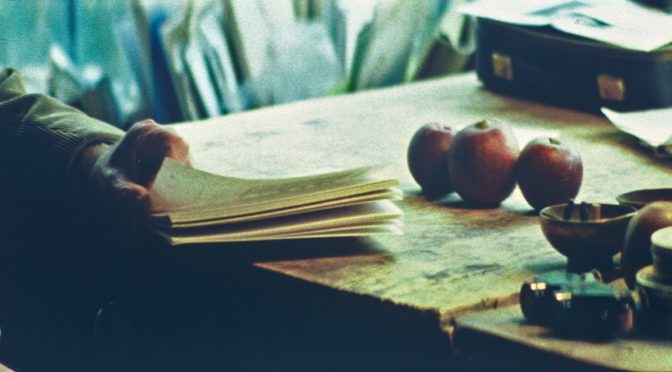This is the preliminary programme. Updates and minor changes will follow.

- This event has passed.
Session 6 – Spectral Presence 1
December 13, 2019 – 11:15 am – 12:45 pm

Falk Messerschmidt
Musee de l’Histoire Coloniale de France
It‘s not the past that dominates us.
It‘s the images of the past.
(George Steiner)
Les statues meurent aussi is the title of an exhibition I realized in Paris this spring. Its title was stolen from a documentary by Chris Marker, Alain Resnais and Ghislain Cloquet. The film addresses the question as to why african artworks are to be found in the Musée de l’Homme when Greek ones are to be found in the Louvre.
Our exhibition took place in the infamous Palais de la Porte Dorée. Erected to become the Musée permanent des Colonies, a place for the promotion of France‘s colonial enterprise and centerpiece of the 1931 colonial exhibition, it has since been faced with an identity crisis.
Our project began in 2013 with the naive idea to go and see the Colonial Museum of France, which we thought we‘d certainly find in Paris. It turned out there is no such place, not in France: nor anywhere in Europe. Even we, the Germans, famous for our premium conscience (albeit monothematic, fragmentary and increasingly contested by the new right) don‘t have an institution solely dedicated to our colonial past.
Instead, we discovered Paris to be an open air museum of colonial vestiges that we subsequently began to index and catalog. Traces of the colonial period are abundant, with most of them classed as national heritage sites, yet the lack of commemorative plaques obscures their history. The majority of objects not tucked away in state archives are hidden in plain sight; images without text, they’re surrendered to oblivion.
If it‘s true what George Bataille wrote and the museum is a colossal mirror in which man contemplates himself, what does the absence of such a mirror imply?
Falk Messerschmidt studied fine art at the Academy of Visual Arts Leipzig with Prof. Timm Rautert and Prof. Christopher Muller, as well as at the Ecole Supérieure des Beaux-Arts de Nantes and the Glasgow School of Art. Various international residencies and exhibitions brought him to e.g. Paris, Rome, Vienna, Berlin, Leipzig and Düsseldorf. He lives and works in Leipzig.
Ilse Van Rijn
’Ghostwriting and Artists’ Texts: We Are Here, But Is It Now?
Contemporary artists’ texts (i.e. texts written and produced by visual artists) are often composed of an amalgam of disparate voices. Roee Rosen’s Sweet Sweat (2009), We Are Here, But Is It Now? (2017) by Raqs Media Collective or Nora Turato’s Nostre Signore del Fuori (Our Ladies from the Outside, 2018), the fragmented, layered, multivocal projects are heterogenous and intertextual works referring to those “ever returning to us, the dead” (The Emigrants, 23). Much like Sebald’s writings, artists’ writerly projects use specific textual strategies enabling them to speak in the name of or on behalf of another person, resulting in the internalization or incorporation of what is invisible, mute or lost.
A Sebaldian form of ghostwriting is at stake in contemporary artists’ texts, I want to argue. The paradoxical emergence of unspeaking, silent voices in both artists’ writings and Sebald’s works, is not only predicated on the recognition of a ‘complex personhood’ (Gordon, Hartman), it happens in various ways as well. This paper studies both what the visual artists’ textual procedures look like in order for wordless presences to return and how they express the notion of ‘complex personhood,’ comparing Sebald’s ghostwriting as a ‘Poetics of History’ (Gray), concentrating on Vertigo and The Emigrants, with Raqs’ We Are Here, But Is It Now?. Through a comparative analysis, this paper intends to get a firmer grip on the specificity of the guiding spirits (ghosts) lending shape to Sebald’s works, simultaneously shedding a light on the relevance of his textual gestures for current artists’ texts and art writing alike.
Ilse van Rijn is programme director and tutor of Approaching Language, master programme at Sandberg Instituut, Amsterdam. She teaches at the department of Modern and Contemporary Art, University of Amsterdam and is part of the Word & Image Research Group (ASCA). Until 2018 / 2019 she has led the theory programme of the Image & Language department, Gerrit Rietveld Academie. Her research situates itself at the crossroads of literature and visual art. She has given papers on the subject (MaHKU 2018, 2019); IAWIS, 2017; ARRG / ASCA 2018) and published on it in Metropolis M and in artists’ publications. Her two book projects include a rewrite of her PhD research, The Artists’ Text as Work of Art (Brill) and a publication on artists’ writings & feminist strategies (Valiz).
